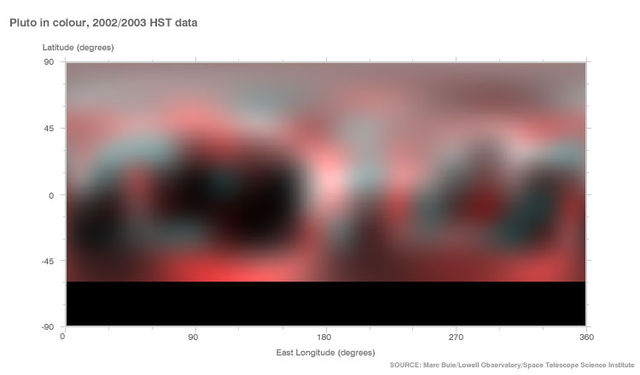 |
This is a file from the Wikimedia Commons. Information from its description page there is shown below.
Commons is a freely licensed media file repository. You can help.
|
| Description |
This newest image of Pluto - our most distant planetary neighbour - shows more detail than any taken before. It might not look like much, but keep in mind that Pluto is only 1,400 miles (2,253 km) across - about two-thirds the size of our Moon - and more than 3.5 billion miles (5.6 billion km) away. It took the Hubble Space Telescope a dozen orbits around the Earth for the Hubble Space Telescope to take the picture, and nearly two years of computer processing to stitch all the information together. The image shows most of the spherical surface of Pluto spread out into a flat map. The red areas indicate methane ice, which seems to be everywhere. The dark areas may be dirty water-ice. Lighter areas indicate nitrogen frost. The bright spot near the centre of the map could be a sign of carbon monoxide |
| Date |
3 November 2005 |
| Source |
NASA HubbleSite
|
| Author |
Marc Buie (Lowell Observatory)/NASA/ESA |
Permission
( Reusing this file) |
Copyright information from http://hubblesite.org/copyright/ - Material credited to STScI on this site was created, authored, and/or prepared for NASA under Contract NAS5-26555. Unless otherwise specifically stated, no claim to copyright is being asserted by STScI and it may be freely used as in the public domain in accordance with NASA's contract. However, it is requested that in any subsequent use of this work NASA and STScI be given appropriate acknowledgement. [...]
|
| Public domainPublic domainfalsefalse |
 |
This file is in the public domain because it was solely created by NASA. NASA copyright policy states that "NASA material is not protected by copyright unless noted". (See Template:PD-USGov, NASA copyright policy page or JPL Image Use Policy.) |
|
|
|
Warnings:
- Use of NASA logos, insignia and emblems are restricted per US law 14 CFR 1221.
- The NASA website hosts a large number of images from the Soviet/ Russian space agency, and other non-American space agencies. These are not necessarily in the public domain.
- Materials based on Hubble Space Telescope data may be copyrighted if they are not explicitly produced by the STScI. See also {{ PD-Hubble}} and {{ Cc-Hubble}}.
- The SOHO (ESA & NASA) joint project implies that all materials created by its probe are copyrighted and require permission for commercial non-educational use.
- Images featured on the Astronomy Picture of the Day (APOD) web site may be copyrighted.
|
File usage
The following pages on Schools Wikipedia link to this image (list may be incomplete):
SOS Childrens Villages aims to make Wikipedia suitable for young learners. SOS Children's Villages helps more than 2 million people across 133 countries around the world. Help another child by taking out a sponsorship.





